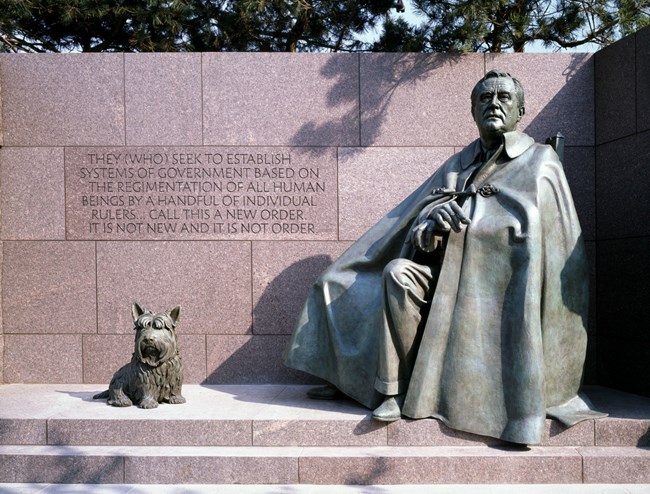
President Bill Clinton dedicated the Franklin Delano Roosevelt (FDR) Memorial on May 2, 1997. Different from the previous presidential memorials, the FDR Memorial uses elements of stone, water, and landscaping to tell the story of FDR’s presidency in a more approachable way. Quotes are at eye level and the statues are at or close to ground level and were meant to be touched. The memorial consists of five outdoor rooms- one as a prologue and four for the unprecedented four terms of FDR. The fountains and pools placed throughout the memorial represent the important role water played in FDR’s life. The water features and the stones also help set the tone during different times in his presidency, from the reflection to chaos. The Prologue Room was added in 2001, funded by the National Organization on Disability with private donations. It features a bronze sculpture of FDR sitting in a wheelchair. The sculpture is life sized and sits away from the wall for maximum accessibility. FDR was diagnosed with polio at the age of 39 and had limited use of his legs. The chair in the statue depicts one FDR designed himself from a kitchen chair and tricycle wheels. Although it was widely known that FDR suffered from polio at the time, he hid the extent of his disability from the public and was rarely seen or photographed in a wheelchair. The rest of the memorial focuses on what happened during FDR’s presidency. Architect Lawrence Halprin described his design in his book The Franklin Delano Roosevelt Memorial. “In the FDR Memorial I hoped to evoke as many emotions and approaches as I could. I wanted the experience of this Memorial to reveal the dramatic story that unfolded during President Roosevelt’s four terms, the twelve years when he was president of the United States. His was a hero’s journey—from the urgency of his first term of office and the New Deal, through his struggles to overcome the Great Depression, through the trauma of World War II, and finally to his search for an honorable and everlasting peace.” Room One introduces FDR's first term as president, with a relief panel illustrating his inauguration. The artist, Robert Graham, used actual film footage as his inspiration. The waterfall in this first room was designed to be simple and direct, much like FDR’s messages. Room Two focuses on the conditions that still faced FDR during his second term. The Great Depression had become the worst financial crisis America had ever experienced. One sculpture, crafted by George Segal, shows a line of men waiting for free bread in an urban setting. Nearby, a farmer and his wife represent the struggles in rural America. And in a third structure, a man sits by his radio, listening to one of the many "fireside chats" that Roosevelt used to communicate directly with Americans. Beyond these sculptures, the room honors FDR's New Deal projects and their impact on the country. These social and economic programs were often known by their initials, including the Civilian Conservation Corps (CCC), the Public Works Authority (PWA), the Social Security Act (SSA) and 51 others. These programs helped lift Americans out of the Great Depression, while completing major infrastructure projects across the country and large arts projects around Washington, DC. The waterfall in this room represents the Tennessee Valley Authority (TVA) program, which used flood control methods to improve irrigation for farmers out west. Robert Graham’s five bronze bas-relief panels are comprised of a mixture of scenes from New Deal projects, impressions of hundreds of people representing the diversity of people affected by the programs, and project initials in letters and braille. The artist used braille to both encourage touch and to bring attention to the Roosevelt administration’s concern for people with disabilities. The Works Progress Administration (WPA) produced braille texts for the people with visual impairments. The five cylinders show the negative (or reverse) images of the wall panels. The cylinders represent a technique that artists used to make impressions in clay and are meant to demonstrate the positive impacts of the New Deal programs on the relief panels. Room Three focuses on the impacts of World War II. It features a chaotic waterfall and a scattering of blocks, representing destruction. Several blocks are labeled, "I hate war," from an FDR speech. A large sculpture of President Roosevelt sits nearby, with his faithful canine companion, Fala, by his side. Room Four includes a still pool of water for reflection below a low-relief panel showing FDR's funeral procession down Pennsylvania Avenue. FDR died of a stroke on April 12, 1945, a few months into his fourth term of office. Here also stands a statue of his wife, First Lady Eleanor, the only depiction of a First Lady in a presidential memorial. Behind her hangs the emblem of the United Nations. Eleanor Roosevelt was the first U.S. delegate and helped craft the United Nations Declaration of Human Rights after FDR's death. A timeline of FDR's life is carved into the steps of this room's amphitheater.
Memorial Facts Construction Started: September 16, 1991 Dedication: May 2, 1997 (Prologue room dedicated January 10, 2001) Size and Location: 7.5 acres along the southwest side of the Tidal Basin Designer and Landscape Architect: Lawrence Halprin Sculptors: Robert Graham, George Segal, Neil Estern, Tom Hardy, Leonard Baskin Stone: Largest single stone 4.5 tons and 31,269 granite stones (pinkish carnelian from South Dakota, gray from Minnesota) Water: Over 100,000 gallons of water flow through seven fountains and pools Layout: Five outdoor rooms represent a prologue plus each of his four terms in office |
Last updated: May 3, 2022
